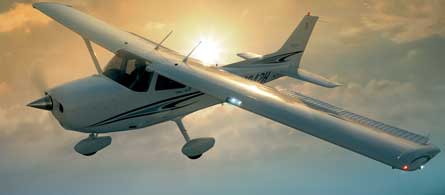Bye Energy says its electrified Cessna 172N aircraft modified with 318kg (700lb) Lithium batteries and an electric motor is progressing towards first flight in the first quarter of 2011.
In addition to mounting its first test motor, the company chief executive George Bye says he will reveal in mid-November a "large partner" who has been "quietly working with us" to develop electronic displays that will replace the piston-powered single's engine gauges with energy management information.
The project, part of the company's "Beyond the Edge" clean energy initiative, is expected to terminate in a supplemental type certificate for a two-seat version of the 172 in 12-18 months and a four-seat version in two to three years, says Bye chief operating officer, Charlie Johnson, a former president at Cessna Aircraft.
Normally a four-seat aircraft, the initial electric 172 will have only the two front seats with batteries in the place of the rear seats, a configuration Bye says will provide some gross weight margin, compared with a C172, with 160 litres (42USgal) of fuel.
 |
|---|
© CessnaBye Energy has modified a Cessna 172N aircraft with 318kg (700lb) worth of Lithium batteries and an electric motor |
The company is targeting a 2h endurance for the aircraft, making it suitable for the training market, where flights often last for 1h or less.
Although the company owns the aircraft undergoing modification, Johnson says Bye Energy has an "agreement to co-operate" with Cessna on the project, and ideally, maintenance services would be provided by Cessna's servicing network.
At the Experimental Aircraft Association's AirVenture show in Oshkosh in July, Cessna revealed that it collaborating with Bye "to design and develop an electric propulsion system for a Cessna 172 proof-of-concept aircraft". At the time, Bye said the aircraft would fly by year's end. The proof-of-concept aircraft will use a two-blade, fixed pitch propeller.
Bye has not yet set a price for the conversion, although he expects that it will be on par with a high-end 160hp (119kW) piston engine replacement for the C172 - about $50,000. Batteries are being designed to last five to seven years at flight school utilisation rates, he adds.
The STC aircraft will include a McCauley six-blade composite propeller that company says will be capable of charging the batteries during descents. On the ground, Bye says recharging stations will be able to provide enough energy for one flight hour in just 15min. The aircraft will also have an option for solar cells on the tops of the wings, offering a full recharge with four days of sunlight.
Proposed recharge times could be somewhat optimist judging by Yuneec International's e430 electric two-place aircraft, scheduled for certification and a production start in 2011. The e430 has a 87kg Lithium polymer battery that requires at least 1h of charge time for its 2h maximum endurance.
Source: Flight International























